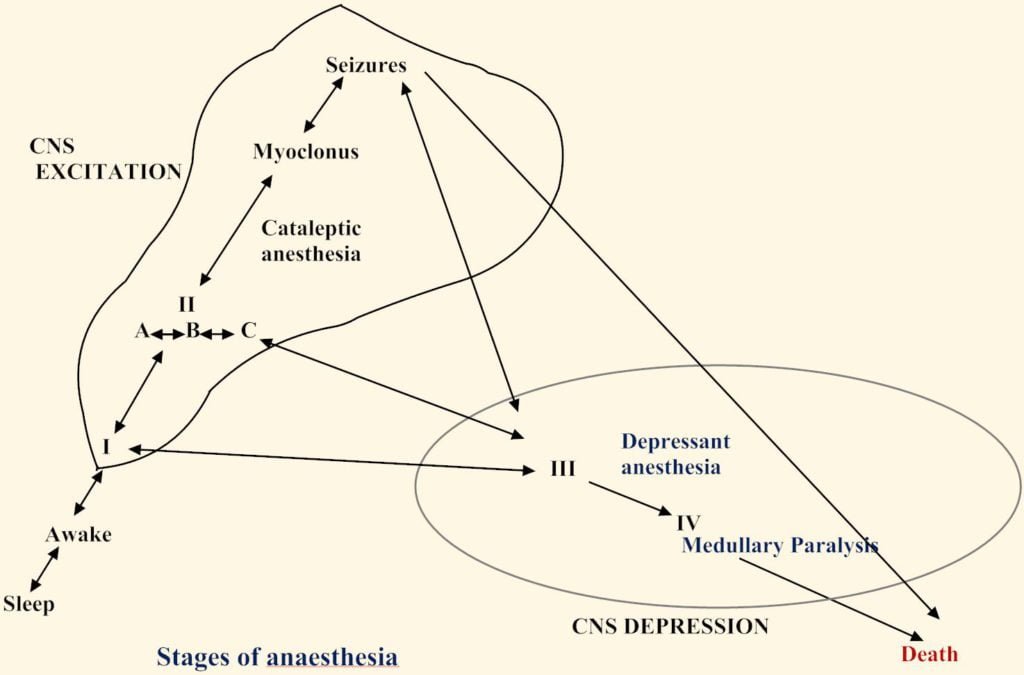TABLE OF CONTENTS
Anesthetics in animals
Anesthetics in animals is defined as total but reversible loss of sensation in a particular part of the body (local anesthesia) or in the entire body (general anesthesia) which results from administration of a drug (or drugs) that depress the activity of part or all of the nervous system.
Chronological events in development of anesthetic agents
- 1540 – Paracelsus recorded anesthetic effect of ether in chicken
- 1800 – Sir Humphry Davy suggested anesthetic effect of nitrous oxide
- 1842 – Ether first used as anesthetic in human
- 1862 – Nitrous oxide was reintroduced in humans
- 1875 – Chloral hydrate was introduced
- 1878 – Cocaine suggested for local anesthesia
- 1930’s – Barbiturates was introduced
- 1950 – Phenothiazine was used tranquilizers
- 1956 – Halothane was introduced
- 1971 – Xylazine and Ketamine were introduced
- 1975 – Establishment of the American College of Veterinary Anesthesia
- 1985 – Isoflurane was introduced
- 1989 – Propofol was introduced
Principles of anesthesiology
The word anesthesia is derived from the Greek word meaning “insensible” or “without feeling”. The word does not necessarily imply loss of consciousness. Anesthesia is defined as total but reversible loss of sensation in a particular part of the body (local anesthesia) or in the entire body (general anesthesia) which results from administration of a drug (or drugs) that depress the activity of part or all of the nervous system. In veterinary practice anesthetics are used for the following reasons-
- Elimination of sensibility to noxious stimuli
- Humane restraint of animal (eg. to protect the animal / personnel, facilitate diagnostic or surgical procedures)
- Specific biomedical research tool
- Control of convulsions
- Euthanesia
Types of anesthesia produced by drugs
- Local/regional anesthesia – Drugs placed in close proximity to nerve membranes causing nerve conduction thus blocking sensory response. Based on the application of the drugs (anesthetics)
- Topical or surface anesthesia
- Infiltration anesthesia
- Subdermal
- Regional
- Perineural
- Peridural
- Subarachnoid
- General anesthesia – State of controlled, reversible CNS depression (including unconsciousness) produced by one or multiple drugs
- Injectable
- Inhalation
- Balanced
Preanesthetic drugs
Preanesthetic use of drugs prior to anesthesia to have smooth and safe induction of anesthesia and to establish balanced anesthesia.
- Merits of preanesthetic medication-
- Alleviate or minimize pain
- Allay apprehension
- Facilitate handling
- Minimize undesirable reflex actions
- Supplement general anesthesia – decrease dose of anesthetic and add extra analgesia and sedation
- Minimize events in recovery
Major classes of drugs used as preanesthetic
- Tranquilizer – sedatives: Acepromazine, Chlorpromazine, Promethazine, Diazepam, Midazolam, Droperidol, Azaperone
- Hypnotic sedatives : Pentobarbital, Chloral hydrate
- Opioid analgesics : Morphine, Pethidine, Fentanyl, Pentazocine
- α2 agonists : Xylazine, Detomidine
- Dissociatives : Ketamine
- Cholinolytics : Atropine, Glycopyrrolate (these agents inhibits the secretory activity of salivary glands that may help in prevention of regurgitation)
Complications of preanaesthetics
- Opioids: respiratory depression, hypotension
- Atropine: Mydriatic
- α2 agonists : cardiac depression
Preanaesthetic agents may potentiate anaesthetic toxicity and prolong the recovery.
Neuroleptic analgesia
A combination of neuroleptics (benzodiazepines, butyrophenones or phenothiazines) + opioids derivatives.
At lower doses– produce preanesthetic effect
At higher doses– Neuroleptic analgesia which is enough depression to cause surgical anesthesia
Popular combinations: Fentanyl + Droperidol ,Fentanyl + Fluanisone, Etorphine+ Acepromazine
Properties of an ideal general anesthetic
- Non irritant
- Free from disagreeable odor
- Produce a pleasant, rapid and smooth induction
- Allow a rapid recovery
- Have a wide margin of safety
- Produce adequate muscular relaxation
- Should not produce capillary bleeding
- Easily and inexpensively produced
- Should be non-explosive and stable during storage
- Excretion and/or metabolism of the anesthetic agents should be sufficiently rapid so that residues do not persist in the edible tissues of food producing animals
Stages of anesthesia
The stages of anesthesia are divided into distinct packages, each correlating with a particular set of physiological responses or reflexes. The organizational scheme includes four stages of anesthesia.

- Stage I
- This stage is also known as the stage of analgesia or stage of voluntary excitement or stage of analgesia and amnesia.
- This period begins from the beginning of induction to the loss of consciousness.
- The patient exhibits voluntary resistance to restraint and to anaesthetic vapours.
- Release of adrenaline due to excitement and fear causes increase in blood pressure and pulse
- Stage II
- This stage is also known as the stage of delirium or stage of involuntary excitement or stage of uninhibited action.
- This period begins from the loss of consciousness to onset of automatic respiration. There will be apparent excitement. Patient may show struggle, hold the breath, muscle tone increases, jaws are tightly closed, breathing is jerky, vomiting, involuntary micturition and defecation noticed. Pupillary dilatation, increase in heart rate and blood pressure due to sympathetic stimulation are noticed.
- Stage III
- This stage is also known as the stage of surgical anaesthesia. It is divided into four planes as Plane 1, Plane 2, Plane 3 and Plane 4.
- This period begins from the onset of automatic respiration to respiratory arrest.
- Plane 1 – Light surgical anaesthesia – roving eye balls and plane ends with eyes becoming fixed.
- Plane 2 – Moderate surgical anaesthesia – loss of corneal and laryngeal reflex.
- Plane 3 – Deep surgical anaesthesia – Pupil starts dilating and light reflex is lost.
- Plane 4 – Excessive surgical anaesthesia – intercostal paralysis, shallow abdominal breathing.
- Stage IV
- This stage is also known as the stage of medullary paralysis or respiratory paralysis.
- This period is between respiratory arrest and cardiac arrest.
Note
Not all anesthetics in animals display all the stages of anesthesia but Ether induces all stages of anesthesia.
Ultra short acting barbiturates induces stages I, III and IV
Dissociative anesthetics induces stages I and II
Halothane, Isoflurane induces stages I, III and IV